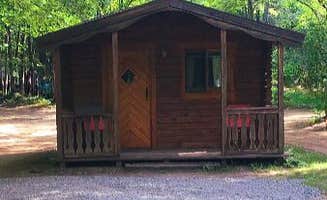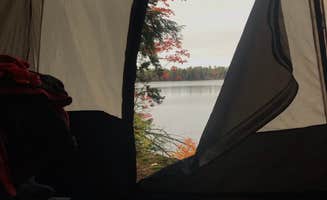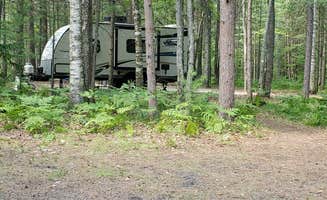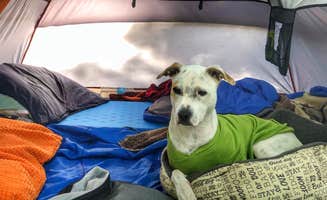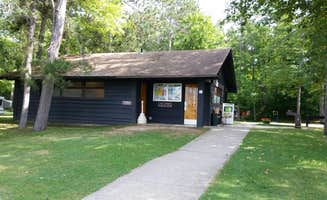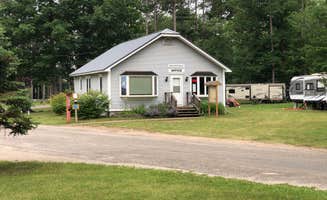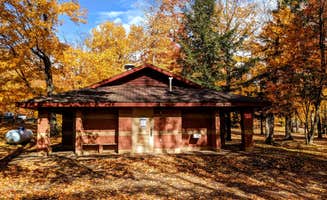The Au Train area sits between Pictured Rocks National Lakeshore and Hiawatha National Forest, creating a strategic camping hub for exploring Michigan's Upper Peninsula. Elevation ranges from 600-900 feet, with summer temperatures typically between 65-80°F. Campsites throughout the region vary from developed areas with electric hookups to remote dispersed options requiring self-sufficiency.
What to do
Waterfall exploration: 15-minute drive from Au Train to several cascading falls. "We explored area, kayaked Pictured Rocks, hiked Miners Falls (relaxing 1 mile with ability to get down to water), could have stayed longer...great area!" shares a visitor at Munising Tourist Park Campground.
Fall color viewing: Peak foliage typically mid-September through early October. "We will be back in the early fall to see the colors change," notes a camper from Superior Times, who also enjoyed fishing and recreational activities during summer visits.
Lake swimming: Variable water temperatures ranging from 55-70°F depending on season. "Private beach was cold but we got in every day," according to one camper who found a cancellation spot with waterfront access for one night and ended up staying three.
ORV/ATV trail access: Direct connections to extensive trail systems. "There is direct trail access from the property, and they provide a free ORV hand washing station and air for tires," notes a reviewer at Jack Pine Lodge and Campground, highlighting amenities for riders including 91 octane fuel on site.
What campers like
Lakefront campsites: Direct water access from many sites. "Our site was clean and comfy! The fire pits were really nice, too!" reports a camper at Little Lake State Forest Campground, emphasizing the importance of bug spray for comfortable outdoor time.
Dark sky viewing: Minimal light pollution in more remote campgrounds. "In the middle of the National Forest, smack in the middle of the UP...you'll get an amazing night sky and great camping hosts," writes a visitor who appreciated the central location despite attractions being about 45 minutes away.
Privacy between sites: Tree buffers at several campgrounds provide separation. "I love that the campsites are not on top of each other and there are trees between the neighboring campsite. They cut tree branches to clean open spots for RVs," notes an appreciative camper.
Hiking trail access: Direct connections to trail systems from campground perimeters. "The loop around the lake was a nice walk to start the day," shares a visitor to Colwell Lake Campground, who enjoyed the quiet atmosphere and privacy of their site.
What you should know
Reservations essential: Peak season fills quickly from June through August. "Took a chance of finding a spot here in June and there was a cancellation with a waterfront spot for one night," reports one camper who moved to overflow for additional nights after discovering availability.
Rustic tent options: Walk-in sites available at several campgrounds for more seclusion. "The tent sites are all walkin, with a tent parking area and then various distances to hike in along a path to the different tent camp sites," explains a camper at Munising Tourist Park, noting they provide wagons in the parking area for hauling gear.
Bathroom facilities vary: Pit toilets common at rustic sites; showers at developed campgrounds. "The bathroom facilities are maybe 150 yards away, not a bad walk," describes a tent camper who stayed at one of the rustic spots right on Lake Superior for $25/night.
Cell service limitations: Coverage gaps throughout the area, especially in forested campgrounds. "Cell service is almost non existent and quite a few generators running," notes a visitor to Colwell Lake Campground who still enjoyed the beachfront access and daily bathroom cleaning.
Tips for camping with families
Toy/activity amenities: Some campgrounds provide recreational equipment. "The kids had a lot of fun, they have a lot of outdoor toys," reports a parent who stayed at Superior Times, though also noting there "were kids everywhere" during their stay.
Beach swimming access: Sandy entry points ideal for children at specific campgrounds. "Each site on the lake side of the loop has their own access to a path along the lake and a spot to easily tie off a boat," describes a camper at Colwell Lake Campground, where the "clear water" provides good swimming conditions.
Educational ranger programs: Scheduled activities during summer season. "We enjoy the ranger programs that are offered, and the camp hosts are so friendly!!" enthuses a repeat visitor to Twelvemile Beach Campground, who loves exploring the beach and hiking trails directly from the campground.
Bug management: Insect pressure varies by season and location. "The mosquitos came in droves and were absolutely ravenous...unphased by a number of citronella candles, obscene amounts of bug spray," warns a family camper, suggesting early spring brings the heaviest insect activity.
Tips from RVers
Limited hook-up options: Full service sites concentrated at specific campgrounds. "If you're not lucky enough to get one on the waterfront, then there's just crowded, open sites that will possibly be sharing water and electricity with others," cautions an RVer who recommends bringing extra hoses and cords.
RV site selection: Size restrictions at many campgrounds limit larger rigs. "Just off M-28, down the right side road a bit you will see campfire remnants and a spot where people tend to park on the left," notes a visitor to Hickey Marsh Dispersed Camping, clarifying it works for smaller vehicles but "wouldn't go much bigger" than their 15-foot trailer.
Generator-free zones: Designated quiet areas at some campgrounds. "Allowed, but there is a generator free zone," explains a reviewer describing Twelvemile Beach Campground, helping RVers who prefer quieter surroundings identify appropriate sites.


